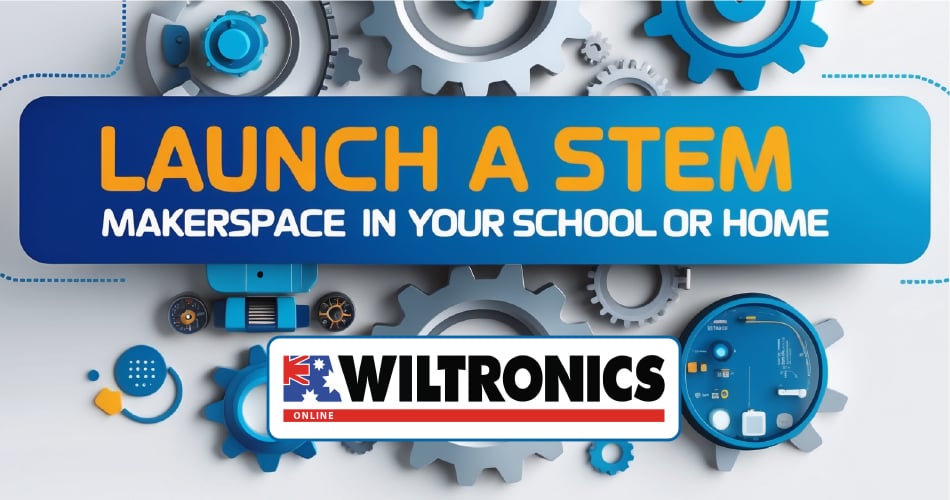
April 30, 2025
Top 10 Must Have Tools for Teaching Chemistry Practicals The ultimate chemistry equipment checklist for Australian school labs—affordable, reliable, and curriculum-ready. Delivering effective chemistry education starts with more than just theory—it requires reliable, hands-on tools that help students safely explore scientific concepts. Whether you're building a new lab or upgrading your current setup, the right equipment can transform lessons into engaging, curriculum-aligned experiences. At Wiltronics, we’ve curated the top 10 essential tools for chemistry practicals, all trusted by educators, aligned with the Australian Curriculum, and available with bulk discounts for schools. 💡 Why Use High-Quality Tools for Chemistry Practicals? ✅ Supports hands-on science learning ✅ Meets Australian Curriculum standards (Years 7–12) ✅ Improves experiment accuracy and classroom safety ✅ Boosts student engagement and real-world skills ✅ Saves money through bulk education discounts 🛍️ Why Choose Wiltronics for Chemistry Lab Equipment? 🇦🇺 100% Australian-owned and operated 📦 Massive bulk discounts for schools 🧪 Lab-grade equipment for classrooms 🚚 Fast shipping across Australia 🧠 Expert education team for support and quotes 🔬 Top 10 Chemistry Practical Tools for Classrooms 1️⃣ OHAUS Electronic Balances These classroom-tough balances offer high accuracy and easy operation—perfect for weighing reagents in experiments, titrations, and solution preparation. 🧪 Precision weighing with easy-to-read digital display 🔧 Durable and low-maintenance for busy labs 🎯 Perfect for high school chemistry curriculum standards 💥 Available in bulk for school discounts 2️⃣ Hot Plates with Magnetic Stirrers Heat and mix solutions safely with these dual-purpose tools—ideal for dissolving solutes, chemical reactions, and distillation activities. 🔥 Controlled, even heating 🔄 Magnetic stirring to prevent clumping or uneven solutions ⚠️ Safer than Bunsen burners 📦 Perfect for school science labs and student experiments 3️⃣ PASCO Wireless pH Sensors Go digital with real-time pH monitoring! These wireless sensors are excellent for titrations, acid/base analysis, and inquiry-based science. 📊 Live data capture for analysis and graphing 🧪 Suitable for chemistry and environmental science 🖥 Compatible with tablets and computers for student-led investigations 🎓 Supports Science Inquiry Skills and Chemistry (ACSCH101) 4️⃣ Glass Beakers & Measuring Cylinders Every classroom needs durable, heat-resistant borosilicate glassware. Ideal for general mixing, measuring, and observation. ⚗️ Graduated for accuracy 🔥 Thermal shock resistant 🛡 Available in multiple sizes to suit lesson needs 💲 Save 50–60% with bulk school orders 5️⃣ Volumetric Flasks (Class A) Used in precision solution preparation and molarity lessons. These Class A flasks provide trusted accuracy for analytical experiments. ✅ Tight calibration 🧪 Ideal for titration lessons and quantitative analysis 🔬 Used in Years 10–12 Chemistry 📦 Available in glass and polypropylene options 6️⃣ Lab Safety Equipment (Goggles, Gloves & Aprons) Keep students protected during every practical. These lab-grade PPE items are essential for every experiment. 🧤 Sized for students 🥼 Durable and reusable 🔐 Meets WHS and school safety compliance ✅ Bulk pricing available for class packs 7️⃣ Conical Flasks (Erlenmeyer Flasks) Versatile and safe for heating, mixing, and swirling chemicals. Conical flasks reduce spillage and are ideal for titrations. ⚗️ Classic chemistry lab essential 🧪 Works well with rubber stoppers and sensors 🔥 Flame and chemical resistant 🛒 Bulk discounts make classroom outfitting affordable 8️⃣ Test Tubes & Racks Use for heating small samples, qualitative testing, or demonstrating reactions. Every student needs a set for foundational experiments. 🧫 Available with or without rims 🔥 Flame-resistant borosilicate ✅ Sturdy test tube racks included in some sets 📦 Low-cost, high-usage item—great for bulk ordering 9️⃣ Digital Thermometers & Temperature Probes Capture fast, accurate temperature readings during chemical reactions, heating, or thermal energy studies. 🌡️ Easy to read, precise, and safe 🔄 Replace outdated mercury thermometers 📊 Can integrate with data logging systems 🔍 Supports investigation-based learning in middle and senior science 🔟 Burettes & Retort Stands – Precision Titration Tools Titration is a cornerstone of chemistry education, and accurate delivery of liquids is essential. Burettes allow students to precisely dispense solutions while learning about concentration, molarity, and reaction endpoints. 🎯 Designed for senior secondary and VCE Chemistry ✅ Clear volume markings for precision measurement 🧪 Includes support stands, clamps, and easy-flow valves 📦 Available in class kits with bulk pricing for labs 🎓 Curriculum Alignment All products support learning objectives in: Science Inquiry Skills (ACSIS125–ACSIS133) Chemical Sciences (ACSSU187, ACSCH093, ACSCH101) Senior Chemistry Units 1–4 🚀 Ready to Upgrade Your Chemistry Classroom? 👉 Shop Chemistry Equipment Now Build confidence, accuracy, and hands-on skills in your science lessons—with tools you can trust. 🎯 Long-tail keywords: chemistry lab equipment for Australian schools, practical science tools for classrooms, affordable STEM supplies for high schools, must-have science gear for teachers, classroom chemistry setup guide

April 28, 2025
Save Big on Science Glassware: Top 6 Discounted Lab Essentials at Wiltronics Take advantage of up to 60% bulk discounts on premium science glassware—perfect for Australian schools and laboratories! Equipping your science lab has never been easier—or more affordable. Wiltronics now offers huge bulk discounts (up to 50–60% off) across a wide range of high-quality science glassware. Whether you're a teacher, lab manager, or school administrator, this is the perfect opportunity to stock up on durable, curriculum-aligned glassware without stretching your budget. 🧪 Why Bulk Buy Science Glassware from Wiltronics? ✅ Save 50–60% with special education bulk rates ✅ Trusted Australian-owned supplier since 1974 ✅ Laboratory-grade borosilicate and polypropylene glassware ✅ Fast, reliable Australia-wide shipping ✅ Perfectly aligned with Australian Curriculum science requirements 🔥 Top 6 Discounted Science Glassware Products Here’s a closer look at the best deals you can secure today: 1️⃣ Volumetric Flask Class A Glass with Polypropylene Stopper Precision is crucial in science experiments. These Class A volumetric flasks are manufactured from durable borosilicate glass and come with a secure polypropylene stopper. 🔹 Features: Highly accurate calibration Ideal for preparing standard solutions Resistant to chemical corrosion 💥 Bulk Discount: Save up to 60% when purchasing in bulk! 2️⃣ Amber Volumetric Flask Class A with Polystopper Designed for light-sensitive solutions, these amber volumetric flasks protect against UV and visible light damage. 🔹 Features: UV-resistant amber borosilicate glass Tight-sealing polystopper Essential for sensitive chemical solutions 💥 Bulk Discount: Up to 60% off when ordering for multiple classrooms or labs! 3️⃣ Polypropylene Volumetric Flask with Screw Cap Perfect for high-safety environments, these polypropylene flasks are lightweight, shatterproof, and fully autoclavable. 🔹 Features: Chemical-resistant, unbreakable plastic Secure screw-top cap Easy sterilisation for hygiene and reuse 💥 Bulk Discount: Massive 50–60% savings on bulk orders! 4️⃣ Borosilicate Glass Beakers – Low Form with Spout The everyday essential! These robust, low-form beakers feature chemical resistance and heat tolerance for versatile lab applications. 🔹 Features: Wide range of volumes Easy-to-read graduations Precision pouring spout 💥 Bulk Discount: Up to 60% off for education sector bulk purchases. 5️⃣ Borosilicate Measuring Cylinders – Hexagonal Base Ensure precise volume measurement with these durable measuring cylinders, featuring stable hexagonal bases to prevent spills. 🔹 Features: Clear volume graduations Stable design prevents tipping Thermal shock resistance 💥 Bulk Discount: Take advantage of significant savings when buying for your entire science department. 6️⃣ Standard Glass Test Tubes Essential for any school laboratory, these borosilicate test tubes are perfect for safe heating, mixing, and chemical reactions. 🔹 Features: High thermal and chemical resistance Uniform glass thickness Optional rimmed or rimless designs 💥 Bulk Discount: Enjoy 50–60% savings—perfect for equipping whole classes! 📚 Curriculum-Aligned and Classroom Ready All featured glassware supports practical requirements of the Australian Curriculum (Science Years 7–12), helping schools meet national standards while making science lessons safer, more accurate, and engaging. 🛒 Why Shop Science Glassware at Wiltronics? 🧪 High-quality, laboratory-grade products 🚚 Fast dispatch Australia-wide 📦 Bulk pricing for schools and education groups 🔒 Trusted, secure online ordering 🎓 Expert advice for lab setup and bulk procurement 🚀 Ready to Stock Your Lab and Save? Take advantage of Wiltronics' science glassware discounts today—before bulk stock runs out! 👉 Shop Discounted Science Glassware Now 🎯 Long-tail keywords: bulk science glassware Australia, discounted laboratory glassware for schools, buy chemistry glassware online, classroom science glassware wholesale

April 24, 2025
Must Have Electronics Skills for STEM Students
Essential electronics techniques every STEM student needs—and how Wiltronics kits can help.
In today's digital-driven world, developing solid electronics skills is crucial for any STEM student. Electronics isn't just about understanding how circuits work; it’s about gaining practical experience and essential technical skills that can open doors to future careers in technology and engineering.
At Wiltronics, we've identified key electronics skills and matched them with the perfect educational tools and kits aligned with the Australian Curriculum—helping educators equip students with valuable, real-world competencies.
⚡ Why Electronics Skills Matter in STEM Education
Introducing practical electronics skills to your students:
✅ Boosts problem-solving and critical-thinking skills
✅ Encourages creativity and innovation
✅ Prepares students for careers in engineering and technology
✅ Supports curriculum objectives in Design & Technologies and Science
🎯 Long-tail keywords: essential electronics skills for students, STEM electronics education, practical electronics projects for classrooms
🌟 Why Choose Wiltronics?
Wiltronics supports your STEM classroom with:
✅ Carefully selected, curriculum-aligned products
✅ Bulk discounts for educational institutions
✅ Fast, reliable shipping Australia-wide
✅ Dedicated expert support for teachers and schools
1️⃣ Circuit Building and Understanding
Students should understand basic circuitry, including how to assemble and troubleshoot simple circuits. Practical hands-on experience significantly enhances theoretical learning.
Recommended Tools:
Snap Circuits: Safe, visual, easy-to-use kits perfect for beginners.
Banana Plugs: Essential for flexible, hands-on circuit experimentation.
🔗 Explore Snap Circuits Kits
🔗Banana Plugs
Curriculum Alignment: Design & Technologies (ACTDEP024, ACTDIP030), Science (ACSSU097)
2️⃣ Soldering and Assembly Techniques
Soldering is a fundamental skill that allows students to build permanent electronic circuits and projects. Learning safe, precise soldering techniques opens opportunities for more advanced projects.
Recommended Tools:
Soldering Stations & Kits: Reliable, classroom-friendly equipment that teaches proper soldering practices safely.
🔗 View Soldering Stations
Curriculum Alignment: Design & Technologies (ACTDEP049), Senior secondary electronics projects
3️⃣ Using Multimeters and Testing Equipment
Students must learn how to test and diagnose circuits accurately. A multimeter is an essential diagnostic tool, measuring voltage, current, resistance, and continuity.
Recommended Tools:
Digital Multimeters: Easy-to-read, reliable, and accurate for classroom use.
🔗 Browse Digital Multimeters
Curriculum Alignment: Science Inquiry Skills (ACSIS125, ACSIS129), Design & Technologies (ACTDEK031)
🎓 Practical Tips for Teaching Electronics in Classrooms
Start Simple: Use beginner-friendly kits like Snap Circuits to build foundational knowledge.
Demonstrate First: Clearly model techniques like soldering and multimeter use.
Collaborative Learning: Pair students to foster teamwork and troubleshooting skills.
Real-world Projects: Connect electronics projects to practical, everyday applications.
🚀 Ready to Equip Your Students with Essential Electronics Skills?
Give your students the practical electronics skills they need for the future. Explore Wiltronics' full range of STEM education equipment today!
👉 Shop Electronics Education Kits at Wiltronics

April 22, 2025
Top Lab Tools Every Chemistry Teacher Needs Equip your high school chemistry lab with the best educational tools aligned with the Australian Curriculum. Teaching chemistry effectively requires more than just theoretical knowledge—it demands reliable, quality equipment to create engaging and practical lessons. The right tools help students understand complex concepts through safe, hands-on experimentation and exploration. Wiltronics has carefully curated this list of essential chemistry lab tools, perfectly suited to Australian high schools and aligned with national curriculum standards. 🧪 Why Quality Lab Equipment Matters Quality lab equipment enables teachers and students to: ✅ Conduct safe and accurate experiments ✅ Reinforce classroom learning through practical application ✅ Develop essential lab skills and techniques ✅ Meet Australian Curriculum requirements 🎓 Curriculum Alignment Each selected product directly supports the Australian Chemistry Curriculum: Chemistry (ACSCH046, ACSCH063, ACSCH065, ACSCH092, ACSCH093, ACSCH101) Science Inquiry Skills (ACSIS125, ACSIS129, ACSIS133) 🌟 Why Choose Wiltronics? Wiltronics is your trusted partner for STEM and laboratory education: ✅ Expert-selected, curriculum-aligned products ✅ Bulk discounts for schools ✅ Fast, reliable Australia-wide delivery ✅ Expert support for educators 🔬 Essential Chemistry Lab Equipment Here's our pick of the must-have equipment for any high school chemistry classroom: 1️⃣ Hot Plates with Magnetic Stirrers A hot plate with a magnetic stirrer is essential for mixing solutions and conducting controlled reactions safely and accurately. Ideal for heating, stirring, and dissolving solids. Ideal For: Senior secondary chemistry classes Features: Adjustable temperature and stirring speed, precise control Curriculum Alignment: Chemistry (ACSCH065, ACSCH092) 🔗 View Hot Plates & Magnetic Stirrers 2️⃣ OHAUS Electronic Balances Reliable and accurate balances are crucial for measuring precise amounts of chemicals. OHAUS balances provide dependable measurements, enhancing accuracy in student experiments. Ideal For: Secondary chemistry labs, precise measuring tasks Features: High accuracy, durable construction, easy-to-read display Curriculum Alignment: Chemistry (ACSCH046, ACSCH093) 🔗 Explore OHAUS Balances 3️⃣ PASCO Wireless pH Sensors These digital pH sensors help students easily measure acidity and alkalinity, allowing real-time data collection and analysis during lab activities. Ideal For: Middle to senior secondary science labs Features: Real-time measurements, wireless connectivity, precision accuracy Curriculum Alignment: Chemistry & Biology (ACSCH063, ACSCH101) 🔗 Check Out PASCO pH Sensors 4️⃣ Glassware Essentials: Beakers, Flasks & Test Tubes Quality glassware is indispensable in chemistry classrooms. Durable beakers, Erlenmeyer flasks, and test tubes ensure reliable experimentation and accurate results. Ideal For: All secondary school chemistry classes Features: Heat-resistant, chemical-resistant, clearly marked measurements Curriculum Alignment: Chemistry practicals (Years 7–12) 🔗 Shop Chemistry Glassware 5️⃣ Safety Equipment: Goggles, Aprons, and Gloves Keeping your students safe is paramount. High-quality personal protective equipment (PPE) like goggles, gloves, and lab aprons ensures student safety during experiments. Ideal For: All chemistry lab activities Features: Comfortable, protective, durable Curriculum Alignment: Laboratory safety standards (Years 7–12) 🔗 Explore Safety Equipment 📚 Teaching Tips for a Successful Chemistry Lab Prioritise safety: Always emphasise safe lab practices and proper use of PPE. Preparation: Clearly explain procedures, demonstrate equipment use, and supervise closely. Real-world relevance: Link practical activities to everyday applications (e.g., acidity in foods, reactions in medicine). Encourage inquiry: Allow students to predict outcomes, record observations, and draw conclusions. 🚀 Ready to Equip Your Chemistry Lab? Provide your students with the best chemistry lab experience. Get quality, durable, and reliable equipment today. 👉 Shop Chemistry Lab Equipment at Wiltronics 🎯 Long-tail keywords: chemistry lab tools for Australian schools, high school chemistry equipment, essential lab equipment for science classes

April 17, 2025
Teaching Electricity and Circuits: Top Kits for Classrooms Essential STEM kits and tools for teaching practical electronics skills aligned with the Australian Curriculum. Introducing students to electricity and circuits in the classroom provides hands-on learning experiences that build foundational STEM skills. With the right resources, teachers can make complex concepts approachable, interactive, and enjoyable. Wiltronics has selected the top educational kits designed specifically for Australian classrooms, each aligning perfectly with national curriculum standards. 🔋 Why Teach Electricity & Circuits in STEM? Understanding electricity and circuits is crucial for students. It helps them: ✅ Develop practical skills in problem-solving and engineering ✅ Enhance logical thinking and analytical skills ✅ Gain hands-on experience with real-world technology ✅ Meet Australian Curriculum outcomes in Science and Technology 🌟 Why Wiltronics for Your Classroom Needs? Wiltronics is your trusted educational partner, providing: ✅ Expert-selected, curriculum-aligned tools ✅ Affordable bulk pricing for schools ✅ Fast delivery Australia-wide ✅ Dedicated education support 🛠️ Best Classroom Kits for Teaching Electricity & Circuits Here are our top picks—each designed for ease-of-use, safety, and curriculum relevance: 1️⃣ Snap Circuits Electronic Kits Snap Circuits are the perfect introduction to electricity and electronics. Using colourful, snap-together components, students can safely explore electrical principles without soldering. Ideal For: Primary and early secondary students Skills Developed: Circuit basics, electrical components, logic skills Curriculum Alignment: Science (ACSSU097, ACSSU117), Design & Technologies (ACTDEK020) 🔗 Explore Snap Circuits Kits 2️⃣ ARD2 Arduino-Compatible Kits Wiltronics’ ARD2 Kit blends coding with electronics, guiding students through 26 structured lessons on circuits, sensors, and programming logic. Ideal For: Upper primary and secondary students Skills Developed: Electronic circuits, coding, sensor integration Curriculum Alignment: Digital Technologies & Design and Technologies (ACTDEP024, ACTDIP031) 🔗 View ARD2 Arduino-Compatible Kits 3️⃣ Banana Plugs & Test Leads These practical classroom essentials allow students to easily construct, test, and modify circuits. Perfect for lab demonstrations, experiments, and troubleshooting lessons. Ideal For: Secondary science and technology labs Skills Developed: Circuit assembly, electrical troubleshooting, experimental accuracy Curriculum Alignment: Science (ACSSU097, ACSSU182) 🔗 Shop Banana Plugs & Test Leads 4️⃣ IEC Power Supplies and Digital Energy Meters Reliable power supplies and digital meters let students safely explore how voltage, current, resistance, and power work in practical scenarios. Ideal For: Secondary physics labs, circuit demonstrations Skills Developed: Measurement accuracy, circuit understanding, scientific inquiry Curriculum Alignment: Science (ACSSU097, ACSSU182), Physics (ACSPH110) 🔗 Explore IEC Power Supplies & Energy Meters 5️⃣ Soldering Stations and Tools Introduce students to essential electronics construction skills safely. Soldering stations and tools allow older students to build more permanent, practical circuit projects. Ideal For: Senior secondary students, advanced learners, technology classes Skills Developed: Safe soldering techniques, permanent circuit assembly, precision electronics work Curriculum Alignment: Design & Technologies, VCE & senior secondary Technology subjects 🔗 Shop Classroom Soldering Kits 📚 Teaching Tips for Effective Circuit Education Start simple with visual tools like Snap Circuits for younger students. Incorporate interactive projects to build student engagement. Use real-world applications (e.g., traffic lights, simple alarms) to demonstrate concepts. Encourage collaborative experiments to foster teamwork and troubleshooting skills. 🎯 Curriculum Connections Each recommended kit directly aligns with Australian Curriculum outcomes: Science (Years 5-10): ACSSU097 (circuits), ACSSU117 (electricity transfer), ACSSU182 (energy & forces) Design & Technologies: ACTDEP024, ACTDEK020, ACTDEP049 Digital Technologies: ACTDIP031, ACTDIP030 🚀 Get Your Classroom Equipped Today! Empower your students with foundational electronics knowledge and hands-on learning experiences. 👉 Explore Circuit & Electricity Kits at Wiltronics 🎯 Long-tail keywords: circuit kits for schools Australia, hands-on electricity lessons, STEM kits for circuits and electronics

April 14, 2025
Classroom Robotics Getting Started with Essential Tools & Kits Explore beginner-friendly robotics kits, sensors, and coding platforms designed specifically for Australian classrooms. Introducing robotics into your classroom can spark incredible enthusiasm for STEM subjects, encouraging hands-on learning, critical thinking, and creativity. But choosing the right tools can be challenging. At Wiltronics, we've simplified your journey by highlighting the most effective and accessible robotics equipment tailored to beginner learners—perfectly aligned with the Australian Curriculum. 🤖 Why Teach Robotics in Your Classroom? Integrating robotics education helps students to: ✅ Develop practical engineering skills ✅ Enhance logical thinking and problem-solving ✅ Boost engagement with interactive learning ✅ Prepare for future careers in tech and innovation 🎯 Long-tail keywords: beginner robotics kits for schools, classroom robotics resources Australia, curriculum-aligned robotics tools 🌟 Why Choose Wiltronics? Wiltronics is your trusted partner for robotics and STEM education: ✅ Curriculum-aligned equipment ✅ Affordable bulk pricing for schools ✅ Expert educational support ✅ Fast and reliable Australia-wide delivery Edison Robot Kit Edison is a robust, programmable robot designed specifically for classrooms. Students can program it using simple block-based coding languages or progress to Python as they grow their skills. Ideal for: Primary to lower secondary students Features: Easy-to-use interface, durable design, versatile projects Curriculum Alignment: Digital Technologies (ACTDIP020, ACTDIP030) 🔗 Explore Edison Robot Kits at Wiltronics Micro:bit Starter Kits The BBC Micro:bit is a versatile tool perfect for beginner robotics and coding. With built-in sensors and simple programming, it's ideal for integrating electronics with robotic projects. Ideal for: Primary and secondary classrooms, beginners in coding Features: Built-in sensors (motion, temperature, light), visual coding platform (MakeCode) Curriculum Alignment: Digital Technologies (ACTDIP020, ACTDIP030) 🔗 View Micro:bit Kits ARD2 Arduino-Compatible Kit The ARD2 kit from Wiltronics is perfect for students who want to explore both robotics and electronics. With step-by-step lessons, students learn coding and electronic skills in a structured way. Ideal for: Upper primary and secondary students, coding beginners Features: Sensors, motors, Arduino-compatible board, easy-to-follow lesson guide Curriculum Alignment: Design & Technologies, Digital Technologies (ACTDEP024, ACTDIP031) 🔗 Discover the ARD2 Arduino-Compatible Kit 📚 Essential Sensors for Robotics Expand your robotics lessons by incorporating sensors. Popular classroom-friendly sensors include: Ultrasonic Sensors: Measure distance and obstacle detection. Line-Tracking Sensors: Follow lines, useful in competitions and navigation tasks. Infrared Sensors: Detect objects, allowing robots to react to their environment. Temperature and Light Sensors: Integrate real-world data collection into robotics projects. 🎯 Choosing the Right Robotics Kit Select your robotics tools based on: Age and experience level: Beginners benefit from kits with visual, block-based coding. Curriculum needs: Ensure tools match your Australian Curriculum objectives. Interactivity and engagement: Choose kits that inspire students and promote active learning. 🚀 Start Your Classroom Robotics Journey Today Equip your classroom for success with engaging robotics kits from Wiltronics. 👉 Explore Robotics Kits for Your Classroom

April 11, 2025
Integrating Coding into STEM: Best Kits for Your Classroom Essential coding kits for beginner-friendly STEM education in Australian schools. Bringing coding into your STEM classroom is easier than ever with engaging, curriculum-aligned educational kits. Coding not only builds foundational digital skills but also enhances problem-solving, creativity, and analytical thinking. At Wiltronics, we’ve curated a selection of beginner-friendly, practical coding kits that perfectly align with the Australian Curriculum—helping educators seamlessly integrate digital technologies into everyday learning. 💻 Why Introduce Coding in STEM? Teaching coding within your STEM curriculum helps students: ✅ Develop essential digital literacy ✅ Enhance critical thinking and creativity ✅ Build practical problem-solving abilities ✅ Gain foundational skills for future careers in technology 📖 Choosing the Right Kit for Your Classroom Each kit provides a distinct advantage depending on your students’ age, skill level, and curricular goals: Micro:bit: Best for introductory coding and younger students. Arduino: Ideal for exploring electronics and coding projects. Raspberry Pi: Suitable for advanced projects and deeper programming experience. Snap Circuits: Great for safe, hands-on introduction to electronics. PASCO Sensors: Ideal for data-driven STEM education and real-time analysis. 🛒 Why Wiltronics for Your STEM Classroom? ✅ Trusted by Australian educators since 1974 ✅ Affordable bulk pricing for schools ✅ Curriculum-aligned equipment ✅ Expert education support ✅ Fast, reliable nationwide delivery 🚦 Best Coding Kits for Classrooms 🖥️ BBC Micro:bit Kits The BBC Micro:bit is a compact, user-friendly device that introduces students to coding using block-based languages (MakeCode) and Python. Easy to use and incredibly versatile, it’s perfect for introducing coding fundamentals in a tactile, visual way. Ideal For: Primary and early secondary students, first-time coders Learning Focus: Basic programming, computational thinking, interactive projects Curriculum Alignment: Digital Technologies (ACTDIP020, ACTDIP030) 🔗 Explore Micro:bit Kits at Wiltronics 🔌 ARD2 Arduino-Compatible Kit Arduino kits combine electronics with coding, allowing students to explore the fundamentals of electrical circuits and programming. Wiltronics’ ARD2 Kit comes with 26 structured lessons, progressively building skills from beginner to intermediate. Ideal For: Upper primary, secondary, STEM clubs Learning Focus: Circuit construction, coding logic, sensors and automation Curriculum Alignment: Digital Technologies & Design and Technologies (ACTDIP031, ACTDEP024) 🔗 View ARD2 Arduino-Compatible Kit 🍓 Raspberry Pi Starter Kits The Raspberry Pi provides a more powerful computing experience, introducing students to computer science and Python programming through practical, hands-on applications. It’s perfect for teaching advanced coding, robotics, and computer science concepts. Ideal For: Secondary students, advanced learners, STEM enthusiasts Learning Focus: Python programming, physical computing, networking, IoT Curriculum Alignment: Digital Technologies (ACTDIP031), senior computing curriculum 🔗 Check out Raspberry Pi Kits 🎚️ Snap Circuits and Electronic Kits Snap Circuits offer a highly visual, safe introduction to electronics and coding fundamentals. Components snap together easily, eliminating the need for soldering, and allowing even younger students to experiment safely and effectively. Ideal For: Primary students, beginner-level STEM activities Learning Focus: Circuit building, electrical principles, introductory electronics Curriculum Alignment: Science and Technology (Years 3–8) 🔗 Explore Snap Circuits Kits 📟 PASCO Wireless Sensors and Data Logging Kits PASCO sensors integrate seamlessly into STEM classrooms, combining science with data analysis and coding skills. These kits enable students to explore physics, chemistry, biology, and environmental science through wireless technology and real-time data. Ideal For: Middle and senior secondary students, science and STEM classes Learning Focus: Data logging, scientific method, sensor technology, coding integration Curriculum Alignment: Science (ACSSU176, ACSSU182), Digital Technologies (ACTDIP031) 🔗 View PASCO Kits at Wiltronics 🚀 Get Your Classroom Coding Today! Empower your students with essential digital skills and bring coding to life in your classroom! 👉 Shop STEM Coding Kits at Wiltronics 🎯 Long-tail keywords: coding kits for classrooms, beginner STEM coding resources, digital technology kits for Australian schools

April 7, 2025
School Holidays STEM Kits : Keep Learning Fun & Exciting!
Hands-On Activities from Wiltronics to Keep Kids Curious and Creative
Looking for ways to keep kids entertained—and learning—during the school holidays? At Wiltronics, we believe holiday activities can be both educational and fun. Our selection of STEM kits for kids makes it easy to turn downtime into productive, hands-on adventures.
Here are five engaging STEM kits, each designed to build critical thinking, creativity, and practical skills while aligning with the Australian Curriculum.
🛒 Get Ready for an Engaging Holiday!
At Wiltronics, we offer:
Fast, reliable delivery across Australia
Expert advice for parents and educators
Affordable, high-quality STEM products
Make this holiday season productive, educational, and fun with Wiltronics!
🚀 Tobbie the Robot 2 Construction Kit
Let kids build and code their very own interactive robot! Tobbie can be programmed with MakeCode or Python, giving children a fun introduction to robotics and coding.
✅ Ages: 8+
📚 Skills: Coding, robotics, mechanical engineering
🎯 Long-tail keywords: robot building kits for kids, holiday coding activities, beginner robotics kit Australia
👉 View Product
🌞 12-in-1 Solar Hydraulic Robot Kit
Explore renewable energy with this innovative kit. Kids build 12 different solar- and hydraulically-powered robots, learning important STEM concepts along the way.
✅ Ages: 10+
📚 Skills: Renewable energy, environmental science, engineering design
🎯 Long-tail keywords: renewable energy STEM kits, holiday activities for young engineers, solar robot kits Australia
👉 View Product
🚗 Air Powered Car DIY Kit
Harness the power of air pressure! Kids construct a car powered purely by air, demonstrating real-world physics in action—perfect for curious young scientists.
✅ Ages: 10+
📚 Skills: Physics, aerodynamics, alternative energy
🎯 Long-tail keywords: physics experiments for kids, DIY science car kit, STEM activities at home
👉 View Product
🥔 Clock Powered by Potato Kit
Combine chemistry and fun by turning potatoes into batteries! Kids learn about electricity and chemical reactions by powering a digital clock using everyday produce.
✅ Ages: 8+
📚 Skills: Chemistry, electricity, environmental science
🎯 Long-tail keywords: science experiments with food, potato-powered clock, educational chemistry kits for kids
👉 View Product
✨ Why Choose STEM Kits for Holiday Activities?
✅ Hands-On Learning: Builds critical thinking and practical skills
✅ Screen-Free Fun: Engages kids creatively and actively
✅ Curriculum-Aligned: Supports the Australian STEM curriculum
✅ Easy Setup: Kits come ready-to-use with instructions
✅ Inspires Future Innovators: Prepares children for future STEM opportunities
👉 Explore More STEM Kits for Kids

April 4, 2025
Launch a STEM Makerspace in Your School or Home
The Complete Guide to Setting Up a Future-Ready Innovation Lab
Creating a STEM makerspace in your school is one of the most effective ways to inspire creativity, critical thinking, and real-world problem-solving in students. Whether you're starting small or building a full tech lab, a makerspace empowers learners to design, experiment, build, and collaborate.
This step-by-step guide outlines how to launch a successful, curriculum-aligned makerspace, and includes must-have tools from Wiltronics to help you get started today.
🔍 What Is a Makerspace?
A makerspace is a hands-on learning hub where students explore science, technology, engineering, and mathematics (STEM) through creative, project-based activities. It’s more than a classroom—it’s a collaborative space for designing, coding, building, and solving real problems.
🎯 Makerspace setup guide for schools, school STEM lab ideas, hands-on STEM activities for students
🚀 Build Your STEM Makerspace with Wiltronics
Wiltronics is Australia’s trusted supplier of classroom-ready STEM tools. We offer:
🔹 Expert advice for educators
🔹 Bulk pricing for schools
🔹 Fast, nationwide shipping
🔹 Kits for primary and secondary levels
🧰 Step 1: Choose the Right STEM Tools for Your Makerspace
A successful STEM makerspace starts with the right tools. Choose equipment that’s modular, safe, and scalable, catering to different year levels and skill sets.
✅ Essential Makerspace Tools from Wiltronics
1️⃣ Soldering Stations
Teach students hands-on electronics skills with classroom-safe soldering tools.
Perfect for: circuit building, repairing electronics, and STEM skill development.
2️⃣ Digital & Analog Multimeters
Let students measure voltage, current, and resistance to understand how circuits work.
Perfect for: electrical troubleshooting and real-time data analysis.
3️⃣ ARD2 Arduino-Compatible Expanded Kit
Packed with 24 lesson-based projects, this kit teaches coding, circuits, sensors, and automation.
Perfect for: learning to code, prototyping, and building smart systems.
4️⃣ Raspberry Pi STEM Educational Bundles
Explore IoT, Python programming, and automation with this mini-computer platform.
Perfect for: coding projects, digital technologies, and robotics clubs.
5️⃣ Snap Circuits & Beginner Electronics Kits
Great for introducing safe, visual circuits to younger students.
Perfect for: Years 5–8, visual learners, and classroom demonstrations.
🎯 Affordable makerspace tools for schools in Australia
🎓 Step 2: Align Your Makerspace with the Australian Curriculum
Your makerspace should support real learning outcomes. These tools and projects align directly with the F–10 Australian Curriculum in:
Design and Technologies (ACTDEP049, ACTDIP030)
Digital Technologies (ACTDIP031)
Science (ACSSU113, ACSSU182)
Use makerspace activities to deliver lessons in:
Engineering design
Programming logic
Circuit construction
Renewable energy
Scientific inquiry
💡 Link hands-on projects to real-world themes like sustainability, smart cities, and robotics.
🛠 Step 3: Start with Scalable, Student-Centred Projects
Focus on open-ended challenges that build confidence, creativity, and curiosity.
Example Makerspace Projects:
🌿 Design a solar-powered environmental sensor
💧 Build a water-level alert system using Arduino
🧊 Create a temperature-controlled fan with a thermistor
🛑 Develop a motion-triggered security alarm
🌱 Automate a smart garden with sensors and displays
These projects can all be built using Wiltronics’ ARD2 Kit, Raspberry Pi, and sensors.
🎯 STEM project ideas for Australian high school students
👩🏫 Step 4: Empower Teachers with Resources & Support
You don’t need to be an engineer to run a makerspace! Wiltronics offers teacher-ready kits, printed guides, and online support.
📘 The ARD2 Kit includes a 26-project workbook
🧰 Starter bundles to fit any budget
🎓 Free advice from STEM education experts
🔗 Step 5: Foster Cross-Curricular Collaboration
Makerspaces are perfect for STEAM learning—connecting STEM with arts, design, and communication. Work across departments to maximise impact.
📊 Maths: Measurements, scaling, ratios
🎨 Art & Design: CAD, 3D printing, product design
📖 English: Journals, documentation, presentations
🌍 Science & Geography: Climate models, environmental monitoring
🎯 Integrated STEM learning through school makerspaces
✅ Final Checklist: What You Need to Start
✔️ Space: a classroom, tech lab, library corner, or multipurpose room
✔️ Tools: soldering station, multimeter, Arduino/Raspberry Pi kits
✔️ Projects: real-world challenges with student voice and choice
✔️ Support: curriculum links, lesson guides, and Wiltronics advice
🔗 Explore Makerspace Tools & Kits:
👉 STEM, Make & Create | Wiltronics

April 1, 2025
Top Physics Demonstration Tools That Wow Every Class
Engaging, Hands-On Equipment for High School STEM Education
Looking for ways to make your physics lessons more exciting and memorable? The right demonstration tools can bring abstract concepts to life, boosting student engagement and improving learning outcomes.
At Wiltronics, we supply high-quality, classroom-ready physics equipment that aligns with the Australian Science Curriculum—perfect for teachers who want to create dynamic, hands-on science experiences.
🎓 Why Physics Demonstration Tools Matter
Using interactive demonstration tools in the classroom:
✅ Reinforces key scientific concepts
✅ Increases student participation & curiosity
✅ Bridges the gap between theory and real-world application
✅ Makes science engaging, memorable, and fun
Whether you're teaching electromagnetism, energy transfer, or motion, these tools help students see the invisible forces that shape our world.
🛠 Build Your Physics Lab with Wiltronics
🔹 Trusted by educators since 1974
🔹 Fast, Australia-wide delivery
🔹 Bulk discounts for schools
🔹 Expert support for STEM lab setups
We’re here to help schools across Australia build future-ready science labs with equipment that drives curiosity and delivers results.
⚡Van de Graaff Generator
High-Voltage Static Electricity Demos
The Van de Graaff Generator is a timeless classroom favourite.
It safely demonstrates static electricity, electric charge buildup, and field interactions—making it a must-have for physics lab.
🔍 Demonstrates:
Electrostatic charge & discharge
Electric fields & conductors
Visual static effects (hair-raising, spark gap)
📘 Curriculum Link: Year 9 – ACSSU182 (Electricity & Energy Transformation)
🔗 Explore Van de Graaff Generators
🧲3D Magnetic Induction Lines Demonstration Kit
This eye-catching kit lets students see magnetic fields in 3D using filings or ferrofluid.
It’s ideal for explaining magnetism, magnetic forces, and field shape around magnets.
🔍 Demonstrates:
Magnetic flux lines
Field strength & direction
Interaction between poles & magnetic fields
📘 Curriculum Link: Year 10 – ACSSU182 (Forces & Magnetic Fields)
🔗 View Magnetic Induction Lines Kit
🧪PASCO Wireless Motion Sensor – Real-Time Kinematics
This smart motion sensor uses ultrasonic pulses to collect accurate data on velocity, displacement, and acceleration, which can be viewed instantly on a computer or tablet.
A great tool for teaching Newton’s Laws and graphing motion.
🔍 Demonstrates:
Position vs. time graphs
Speed, velocity & acceleration
Newton’s First & Second Laws
📘 Curriculum Link: Year 10 – ACSPH101 (Kinematics & Forces)
🔗 View Wireless Motion Sensor
⚙️IEC Digital Energy / Power Meter – Electricity & Energy Use
Teach real-world electrical principles with this digital power meter, which measures current, voltage, power, and energy consumption.
Perfect for circuit labs, Ohm’s Law, and energy efficiency experiments.
🔍 Demonstrates:
Power (P = IV)
Energy usage in real time
Circuit analysis & behaviour
📘 Curriculum Link: Year 9/10 – ACSSU182, ACSIS171 (Electric Circuits & Analysis)
🔗 Explore IEC Power Meter
🔗 Browse All Physics Equipment & Classroom Tools
👉 wiltronics.com.au/product-category/physics
🎯 Long-tail keywords:
“static electricity demonstration equipment for schools”
“optics equipment for high school science labs”
“digital power meter for physics experiments”
“real-time motion sensor for physics classrooms”
“classroom magnetic field demonstration tool”

March 28, 2025
Engaging Girls in STEM: Tools & Strategies That Work
Empower future innovators with hands-on STEM learning from Wiltronics
Creating gender-inclusive STEM education isn’t just a trend—it's a necessity. Girls are equally capable in science, technology, engineering, and mathematics, but confidence, visibility, and relevance often hold them back.
The good news? You can change that. With the right tools and strategies, schools can foster inclusive, inspiring, and future-focused classrooms.
At Wiltronics, we support teachers with hands-on STEM kits, coding tools, and classroom resources that help every student—especially girls—develop confidence, creativity, and real-world skills.
🔍 Why Focus on Engaging Girls in STEM?
✔️ Girls match or outperform boys in STEM subjects during early education
✔️ Underrepresentation in tech, engineering, and physics starts in high school
✔️ Interest is boosted when STEM is hands-on, collaborative, and real-world relevant
🧰 Use Real-World STEM Kits That Inspire Purpose
Girls are more engaged when they understand the "why" behind STEM. Problem-solving, sustainability, and technology-for-good themes make learning meaningful.
✅ Recommended Kits:
🧪 Aligned with : Australian Curriculum, Design & Technologies (ACTDEK020, ACTDIP030)
ARD2 Arduino-Compatible Expanded Kit (24 Projects)
The ARD2 Arduino Compatible Expanded Kit provides specific learning outcomes and hands-on experiences in creating electronic projects using the Arduino platform.
It is a great introduction to Arduino, coding, and a variety of electronic components, including LEDs, buttons, buzzers, sensors, motors, and relays.
Solar & Renewable Energy Kits
This 6 in 1 solar model kit teaches how solar power is used to drive a small motor. The models consist of snap-together parts. Children can build it without the tools required. Great for first-time experimenters.
👩💻 Make Coding Creative and Visual
Many girls thrive when coding is interactive, visual, and connected to real life. Programming LEDs, sound modules, or sensors helps students understand code through physical results.
✅ Best Coding Kits for Girls:
Raspberry Pi Starter Kit
The Raspberry Pi 5 Starter Bundle is great for Raspberry Pi beginners. This bundle includes a black case, HDMI, and Ethernet cables. It also has a microSD card preloaded with the Raspberry Pi OS and a compatible power supply.
ARD2 Kit + Programming Challenges
The ARD2 Arduino Compatible Starter Kit provides specific learning outcomes and hands-on experiences in creating electronic projects using the Arduino platform.
🎯 Try combining code with storytelling, fashion, or environmental science for multi-disciplinary learning.
🔬 Introduce Role Models and Real-World Careers
Representation matters. Girls need to see women in tech, science, and engineering roles.
🧑🏫 Inspire students with role models like:
Dr. Cathy Foley – Australia’s Chief Scientist
Macinley Butson – Young inventor and science communicator
Women in STEM at CSIRO, NASA, Google, and biotech fields
📚 Pro Tip: Link lessons to real-world careers like environmental engineer, UX designer, or robotics specialist.
🧠 Build Confidence Through Safe Exploration
STEM is about trial, error, and learning from failure. Girls often benefit from structured risk-taking—opportunities to explore, iterate, and succeed step-by-step.
✅ Confidence-Building Kits:
Soldering Stations for Classrooms
2-in-1 Solder and Desoldering Station
The ZD917 2-in-1 Solder and Desoldering Station is a versatile tool for soldering and desoldering electronic components. It features a lightweight and ergonomic design, and its soldering iron and desoldering gun are controlled by microprocessors.
Snap Circuits & Beginner Electronics
Electronic Project Snap On Kit
Get electronically creative with the Electronic Project Snap On Kit! With over 80 projects that demonstrate various principles of electronics, this kit is perfect for STEM learning. What's more, the switches, motors and LED's mean you have all that you need to experiment!
Digital Multimeters
DM8100 Digital Multimeter 10A
This 10A Digital Multimeter is ideal for automotive testing and diagnosis. Packed with features and has a large display with 25mm ligh digits. Supplied with temperature probe, rubber holster and probe leads.
🧑🏫 5. Design Inclusive, Creative STEM Spaces
To truly support girls in STEM, classrooms must be places of collaboration, creativity, and curiosity. Shift from “right answer” worksheets to real-world challenges and open-ended design thinking.
🛠 Teaching Tips:
Offer open-ended challenges like “build a rain detector” or “create a digital thermometer”
Encourage mixed-gender teams and diverse problem-solving methods
Showcase student projects around the school or online to build pride and visibility
🧩 How Wiltronics Helps Schools Empower Future STEM Leaders
With Wiltronics, you get: ✅ Hands-on, classroom-tested STEM kits
✅ Curriculum-linked lesson resources
✅ Fast shipping and reliable support
✅ Bulk pricing for schools & education departments
✅ Expert help selecting the right tools for your students
🚀 Ready to Make Your Classroom More Inclusive?
Start building confidence, curiosity, and capability—one hands-on project at a time.
🔗 Shop STEM Kits That Inspire Girls
👉 https://www.wiltronics.com.au/product-category/stem-kits/
🔎 Long-tail keywords: soldering kits for students, beginner-friendly electronics kits, hands-on coding for girls
🔑 Long-tail keywords: engaging girls in STEM education, how to get girls interested in technology, coding kits for female students, STEM programs for high school girls

March 26, 2025
ARD2 Arduino Compatible Expanded Kit - Teaching Electronics
Looking to make your STEM classroom future-ready? The ARD2 Arduino-Compatible Expanded Kit from Wiltronics is the ultimate hands-on learning tool for teaching electronics, coding, and digital technologies—aligned to the Australian Curriculum.
With over 30 components and a complete 26-lesson step-by-step workbook, this kit gives students a guided journey from basic blinking lights to working with sensors, motors, and displays. It’s perfect for high school, upper primary, and maker programs focused on real-world STEM skills.
🔗 Explore the ARD2 Kit at Wiltronics
🎓 Why Use the ARD2 Kit in Your STEM Curriculum?
✅ 26 Hands-On Lessons – From blinking LEDs to ultrasonic sensors and motor control
✅ Curriculum-Aligned – Designed around the F–10 Australian Digital Technologies Curriculum
✅ Plug-and-Play Hardware – Includes UNO R3 board, breadboard, sensors, motors, and more
✅ Beginner-Friendly – No prior coding or electronics knowledge needed
✅ Supports Digital Literacy & Future Tech Skills – Ideal for coding, prototyping, and systems thinking
🎯 Curriculum Connections (Version 8.4)
Design and Technologies – Knowledge & Understanding
ACTDEK004: Forces and energy in systems
ACTDEK020: Digital systems and components
Processes and Production Skills
ACTDEP005, ACTDEP014, ACTDEP024: Design, implement, and evaluate solutions
Digital Technologies – Years 7–10
ACTDIP030: Implement and modify digital solutions
ACTDIP031: Evaluate design ideas, processes, and solutions
🔌 What's Inside the Kit?
✔️ UNO R3-Compatible Microcontroller Board
✔️ 830-Point Breadboard
✔️ LEDs, Resistors, Sensors (Light, Tilt, Temp, Ultrasonic, IR)
✔️ Motors (Stepper, Servo), Joystick Module
✔️ LCD Display, IC Chips (L293D, 74HC595), Buzzer
✔️ USB Cable, Power Supply Module, Jumpers
✔️ Full Printed or Downloadable 26-Project Workbook
📘 Download the ARD2 Lesson Guide
🔍 What Students Will Learn (Sample Projects)
Each project builds skills in electronics, programming logic, input/output systems, and automation.
✅ Lesson 3: Blink the Built-In LED
Learn Arduino basics, digital output, and code structure
✅ Lesson 6: Cascading LEDs
Practice loop functions and sequencing logic
✅ Lesson 9: RGB LED Color Control
Understand analog output and PWM using color mixing
✅ Lesson 14: Temperature Sensor Display
Read analog data from a thermistor to build a digital thermometer
✅ Lesson 21: LCD Display Messages
Use libraries to display output on a 16x2 LCD screen
🧠 Real Classroom Benefits
🎓 Teaches Practical Electronics & Engineering
👨💻 Builds Strong Coding Foundations (C/C++)
🔄 Supports Iterative Design & Creative Problem Solving
💡 Perfect for Project-Based Learning & STEM Clubs
🌐 Prepares Students for Robotics, IoT & Automation Careers
🚀 Who Is It For?
🎒 Secondary Students (Years 7–10)
👩🏫 STEM & Tech Teachers
🛠 Makerspaces & Robotics Clubs
💻 Beginners Learning Arduino or Electronics
Whether you're teaching a term-long STEM unit or running a maker workshop, the ARD2 Kit provides all the tools and structure needed to engage students with future-ready skills.
📈 Why Educators Choose Wiltronics
✔️ Trusted Supplier Since 1974
✔️ Fast Shipping Australia-Wide
✔️ Expert Support for Schools & Educators
✔️ Affordable Bulk Pricing for Education
🛒 Ready to Power Up STEM Learning?
Bring electronics, coding, and design thinking into your classroom with the ARD2 Arduino-Compatible Expanded Kit—designed for maximum engagement, minimal prep, and long-term learning outcomes.
🔗 See More Now from Wiltronics
📘 Download the 26-Project Lesson Booklet

